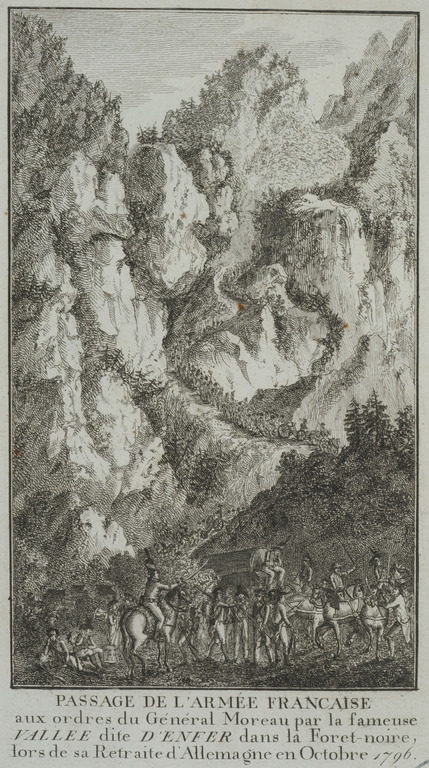General Moreau’s Army, passage from Germany, 1796
In the Rhine valley, 15 kilometers north of Freiburg im Breisgau in the Elz valley, Emmendingen was the site of the main Austrian victory over General Jean Moreau’s retreating French army, which forced the French to withdraw across the Rhine. It was the culmination of the Austrian plan devised in mid-July to gain local numerical superiority and defeat the two French armies individually to win the 1796 campaign in southern Germany.
News of Archduke Charles’s victory over General Jean-Baptiste Jourdan at Würzburg on 3 September had prompted Moreau to abandon his offensive in southern Germany against the Austrian Feldmarschalleutnant Maximillian Graf Baillet von Latour and retreat back up the Danube valley to the Rhine bridges. He defeated Latour at Biberach on 2 October and withdrew down the Höllental between the Black Forest and the Swiss border over 13-15 October, while General Laurent Gouvion St. Cyr’s troops on his left secured Freiburg. After his victory at Altenkirchen on 19 September, Charles had marched south up the Rhine valley with 16,000 troops to join Latour and attempt to defeat Moreau. Charles had committed 8,000 troops to besieging the Kehl Rhine bridgehead opposite Strasbourg, so Moreau, with 16,000 troops massed at Freiburg with his advance guard holding Waldkirch (just southeast of Emmendingen), decided to reopen his communications with Kehl. On 17 October Charles secured Kintzingen, while from the east Feldmarschalleutnant Friedrich Graf Nauendorff (Latour’s advance guard) had reached Schweighausen, but there was little fighting the next day, while Latour joined the archduke.
Both commanders decided to attack on 19 October, but Charles struck first: Feldmarschalleutnant Karl Alois Fürst von Fürstenburg held Kintzingen in the northwest with 4,000 men; Nauendorff with 6,000 troops headed for Waldkirch from the northeast; Feldzeugmeister Wilhelm Graf Wartensleben with 8,500 marched from the north on the Elz Bridge at Emmendingen, alongside Latour with 6,000 men. To the southeast, Generalmajor Franz Freiherr von Fröhlich and Louis-Joseph de Bourbon, Prince de Condé pinned down Moreau’s right wing under General Pietro Maria Ferino in the Stieg valley. St. Cyr’s French division made the main attack on Nauendorff around Bleibach, but the Austrian commander used his hidden detachment at Sieglau to assail St. Cyr’s left and forced the French back through Waldkirch. Wartensleben fought his way into Emmendingen and by nightfall had reached the Elz Bridge, which had been broken by the retreating French. In the meantime, Latour crossed the Elz and reached Denzlingen village. As night fell, Moreau withdrew to a position north of Minburg between Riegel and the Gundelfingen forest to the southeast. Charles renewed the general assault the next day: Wartensleben’s and Nauendorff’s columns drove the French from Langendenzlingen and the Gundelfingen forest, while after four attacks, Latour crossed the Resiam, and Fürstenburg took Riegel.
Moreau’s left wing under General Louis Desaix crossed the Rhine at Breisach the next day, and after a further clash at Schliengen on 24 October, the main French army fell back across the Hüningen Bridge near Basle two days later.
References and further reading Charles, Archduke. 1814. Grundsätze der höheren Kriegskunst. 2 vols. Vienna: Strauss. Volume 2 translated by George Nafziger as Archduke Charles’s 1796 Campaign in Germany (Westchester, NY: Self-published). Phipps, Ramsay Weston. 1980. The Armies of the First French Republic. Vol. 2, The Armées de la Moselle, du Rhin, de Sambre-et-Meuse, de Rhin-et-Moselle. London: Greenwood. (Orig. pub. 1926-1939.)
